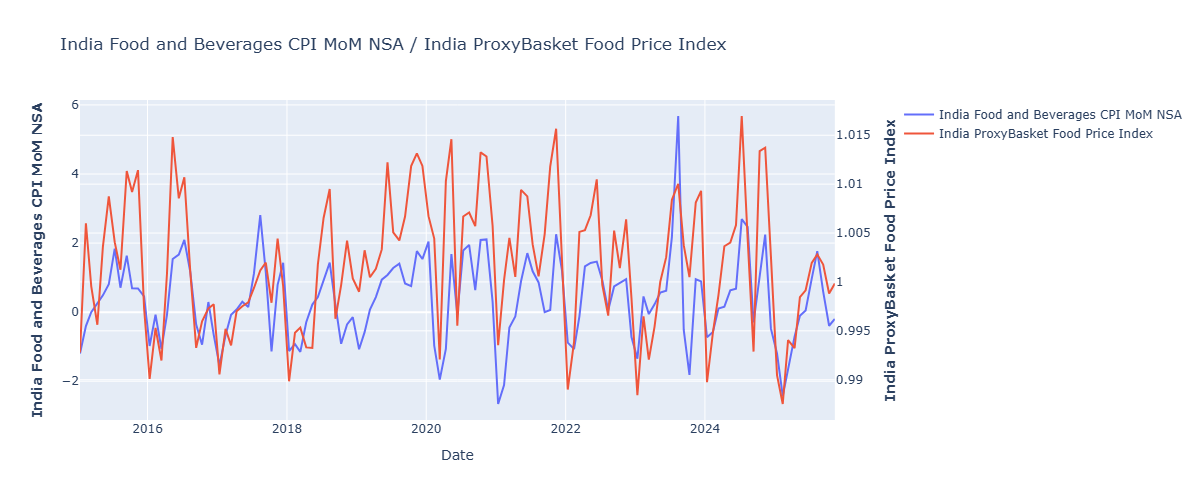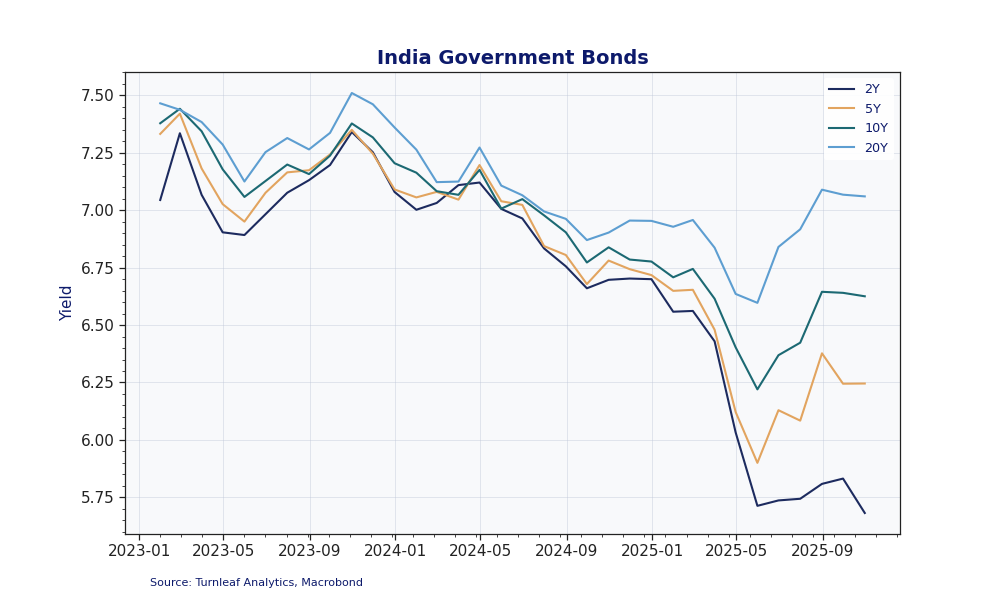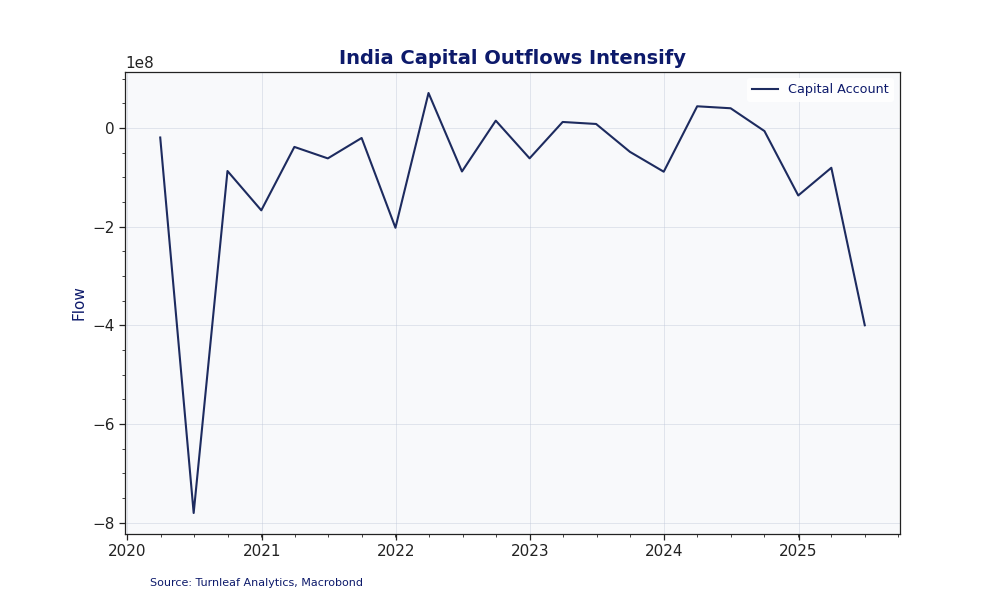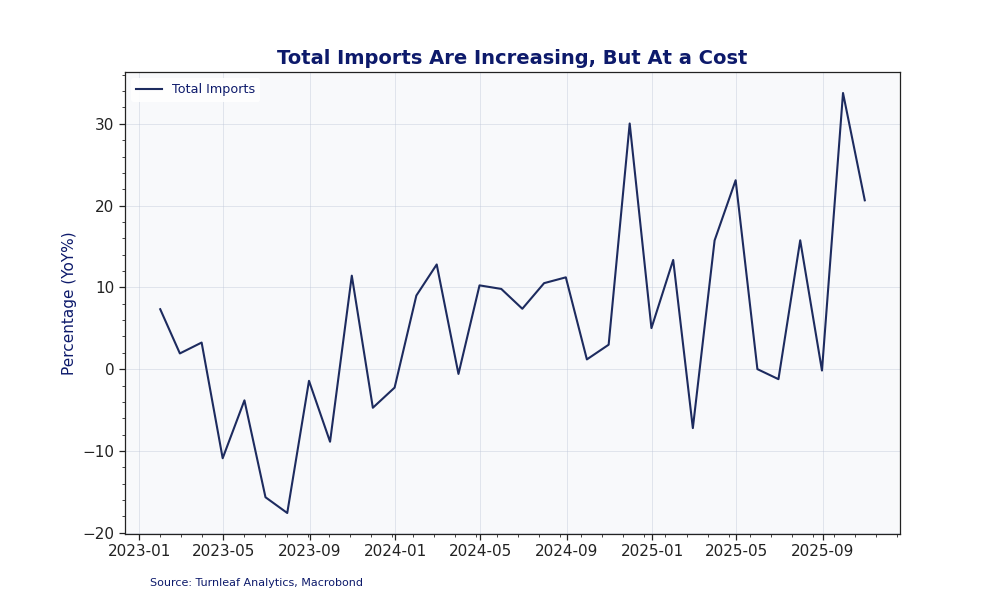Featured Research
Macroeconomic Insights: India CPI – Structural Pressures Emerge
In the past month Turnleaf's 12-month inflation forecast for India has edged lower as the pace of food and energy price increases slowed. This moderation reflects seasonal dynamics and temporary declines in current market prices rather than any meaningful improvement...
Macroeconomic Insights: India CPI – Structural Pressures Emerge
In the past month Turnleaf’s 12-month inflation forecast for India has edged lower as the pace of food and energy price increases slowed. This moderation reflects seasonal dynamics and temporary declines in current market prices rather than any meaningful improvement in the structural forces that keep inflation elevated. Turnleaf’s models show that despite current disinflation, external cost channels including exchange-rate depreciation, tightening freight markets and rising forward energy prices are already rebuilding inflationary pressure beneath the surface. We expect external frictions to continue to push inflation above 3%YoY by the end of 2026 (Figure 1-PAID).
Record Low Food Prices Creates Rebound Risk
India’s headline CPI inflation slowed to 0.25% YoY in October 2025, largely because food inflation fell to -5.02% YoY. The decline was concentrated in vegetables—especially tomatoes, onions and potatoes—as prices normalized after mid-year supply shocks. Turnleaf’s ProxyBasket Food Price Index captured this move by incorporating daily tomato, onion and potato prices, as well as other inputs like India Agricultural Index that help trigger supply interventions and minimum sell prices for farmers (Figure 2).
Figure 2

This unusually low October reading creates a very low base for 2026, so even modest food price increases next year are likely to lift YoY food inflation. Although current data point t higher rainfall and increased sowing in the second half of 2026, any weather-related shock will be amplified by this base effect. Monitoring climate indicators together with Turnleaf’s alternative data like NASA weather metrics and minimum price triggers will be essential to gauge emerging food inflation risks.
Currency Depreciation and External Cost Pressures
The rupee weakened to 89.39 INR/USD as of November 27, 2025, down 5.82% over twelve months and 1.30% in November alone, driven by acute trade frictions with the U.S. and foreign portfolio outflows. Over the past month, 5- and 10-year government bond yields have edged higher while the 2-year remains near cycle lows, indicating that markets are demanding a higher term premium for inflation and fiscal risks even as they continue to price in near-term RBI easing (Figure 3).
Figure 3

Capital flows show about $400 million leaving India in 2025Q2 as global trade volatility weakened appetite for emerging-market risk (Figure 4). For India, this pressure has been amplified by the U.S. decision to impose a 50% tariff in response to India’s deepening energy ties with Russia. Since the start of the war in Ukraine in 2022, Russia’s share of India’s crude imports has jumped from under 1% to nearly 40%, increasing India’s exposure to geopolitical shocks.
Figure 4

Currency depreciation compounds external cost pressures through dollar-denominated freight and commodity prices, effectively hitting India twice. With global shipping costs still slightly above pre-shock norms, imports are more expensive both because of higher USD prices and the weaker rupee. Despite some slowdown after a peak above 30% YoY in September 2025, import volumes—equivalent to 23.5% of GDP in 2024—continue to grow, reinforcing the upside risk to India’s inflation outlook into 2026 (Figure 5).
Figure 5
 To read the rest, visit Turnleaf’s latest Substack post here.
To read the rest, visit Turnleaf’s latest Substack post here.
Research Archive
Macroeconomic Insights: U.S. Inflation Outlook Under Another Trump Presidency
As U.S. economic conditions continue to evolve, Turnleaf will actively monitor inflation trends and publish regular updates to keep you informed. Our focus remains on leading...
Macroeconomic Insights: Turkey’s Two-Front Fight with Inflation and the Lira
Turkey’s central bank has adopted a stringent monetary policy to combat inflation, a stark departure from previous unorthodox strategies. With borrowing costs now at a benchmark...
Inflation Outlook for Canada in October 2024- Producer Optimism, Consumer Pains
Canada’s inflation outlook is shaped by a complex mix of declining energy costs, rising food prices, and evolving trade dynamics. At Turnleaf Analytics, we’re closely tracking...
How Bad is Too Bad? Japan’s Reckoning with Inflation and New Leadership
Japan’s battle with inflation has become a key issue, reshaping public sentiment and influencing recent election results. With the Liberal Democratic Party (LDP)–Komeito...
Turnleaf’s Inflation Outlook for Brazil: Rising Costs Amid Currency Pressures
Turnleaf’s Brazil’ inflation outlook for the next 12 months has undergone an upward revision, driven by several significant factors. While shipping costs have eased, inflationary...
Turnleaf’s October 2024 Economic Forecast: Deflationary Pressures Persist in China
Turnleaf Analytics’ forecast for YoY NSA CPI published in October 2024 suggests an inflation trajectory expected to remain well below 2% over the coming 12 months. Specifically,...
FILS Europe 2024 Takeaways
Paris is home to many things, the Eiffel Tower, the Arc de Triomphe, burgers (ok, I made that one up!). In recent years, Paris' financial community has grown, and indeed, every...
Don’t look back in hanger steak
I'm currently in the queue for Oasis tickets. Rather than mindlessly watching the counter of people in the queue ahead of me fall (currently 184,984 people), I thought I'd start...
The Olympic spirit for forecasting
The Olympics finally finished, and the Paralympics are about to begin. I managed to go to some of the Olympic football matches in both Lyon (in the photo above) and Nice. The...
Eleven years of independence
Regrets become ever more edged with the passing of time. Recalling a time long gone, when perhaps a decision made, was not the decision you should have made, wastes little more...
The human part of machine learning forecasts
I've seen a few videos showing a robot making a burger (here's one of RoboBurger for example). It seems pretty impressive that a machine can create a fresh burger. However, one...
Takeaways from Eagle Alpha London 2024
Over the years the number of datasets which have come to the market have increased significantly. How do data buyers in the buy and sell side find such data? One way has been to...
Takeaways from Berkshire Hathaway 2024
It's springtime in Omaha. It can mean only one thing, the Berkshire Hathaway shareholder meeting is back in town. It is a relatively unusual event in the financial calendar....
Using experience in financial research
I end up buying a lot of books. Inevitably, I end up reading far fewer books than I end up buying. The unread books peer at me from my bookcase, knowing they'll likely never be...
Forecasts and decisions
A lot of measurements go into the perfect burger. First, there's the patty. What is the weight of the patty? How much fat is in the patty? Then there's the other parts. How much...